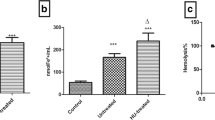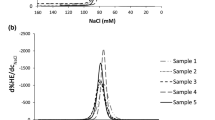Abstract
Erythrocyte microrheology changes were measured by cation-osmotic haemolysis (COH) in healthy donors, patients with ischameic stroke, and patients who died within four days after a stroke. COH in patients with stroke was significantly decreased in comparison with that from healthy donors. In patients who died, COH was significantly decreased compared to patients who survived. The relationship between cationosmotic haemolysis and erythrocyte deformability is discussed.
Similar content being viewed by others
References
Boisseau MR, Freyburger G, Lorient-Roudaut (1986) Changes in blood filterability in cerebrovascular accidents. Wien Med Wochenschr 136:44–46
Ernst E, Matrai A, Marshall M (1988) Blood rheology in patients with transient ischaemic attacks. Stroke 19:634–636
Ernst E, Resch KL, Matrai A, et al. (1991) Impaired blood rheology: a risk factor after stroke? J Int Med 229:457–462
ICSH Expert Panel on Blood Rheology (1986) Guidelines for measurement of blood viscosity and erythrocyte deformability. Clin Hemorheol 6:439–453
Kuzuya F, Haykawa M (1994) Effect of nifedipine on red cell deformability and platelet aggregation in stroke patients. Arzneim Forsch Drug Res 44:1214–1216
Mirossay L, Mojžiš J, Jandošekovà M, et al. (1997) Comparison of two methods in erythrocyte microrheology determination using glutaraldehyde-treated cells. Clin Hemorheol Microcirc 17:187–192
Mokken FC, Kedaria M, Henry CP, et al. (1992) The clinical importance of erythrocyte deformability, a haemorheological parameter. Ann Haemathol 64:113–122
Nicák A, Mojžiš J (1992) Differences in the haemolytic action of mercury ions on human and rat erythrocytes with relationship to the concentration of Na+ and glucose in vitro. Comp Haematol Int 2:84–86
Pečivovà J, Dràbikovà K, Jančinovà V, et al. (1991) Atenlol, exaprolol, and mast cell membranes. Agents Actions 33:41–43
Sakuta S (1981) Blood filtrability in cerebrovascular disorders, with special reference to erythrocyte deformability and ATP content. Stroke 2:824–828
Yoshida H, Satoh K, Takamatsu S (1993) Platelet-activating factor acetylhydrolase in red cell membranes. Does decreased activity impair erythrocytes deformability in ischemic stroke patients? Stroke 24:14–18
Author information
Authors and Affiliations
Rights and permissions
About this article
Cite this article
Mojžiš, J., Nicák, A., Troščák, M. et al. Cation-osmotic haemolysis in stroke patients. Comp Haematol Int 9, 83–85 (1999). https://doi.org/10.1007/BF02585541
Issue Date:
DOI: https://doi.org/10.1007/BF02585541




